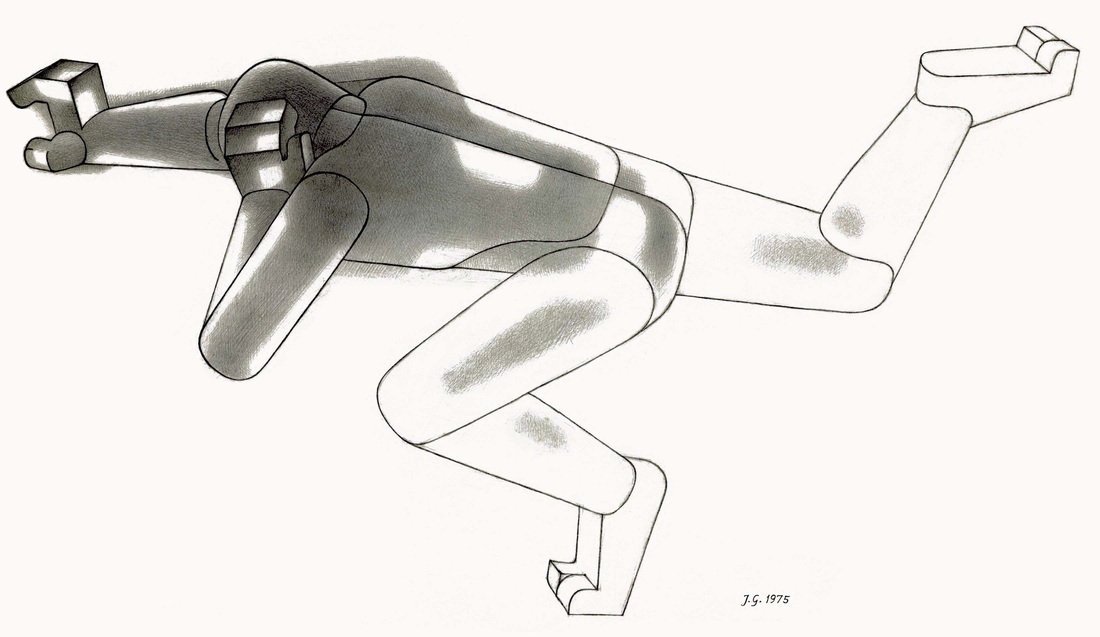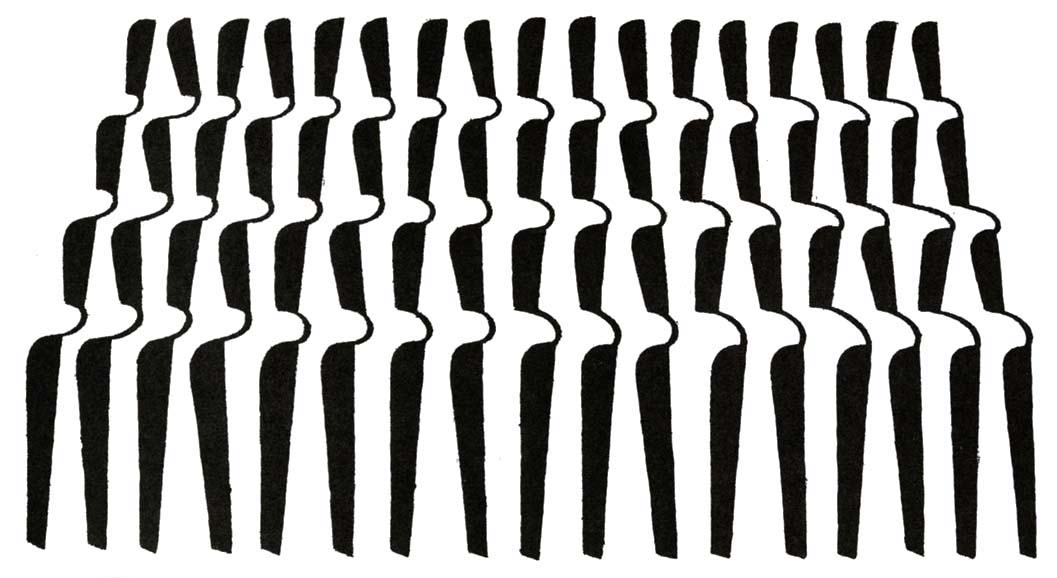|
Whatever thoughts bounce in and out of our brains or tumble from the lips as speech all belong to their area of interest and purpose of expression. Once my dictionary fell open on the word “atomic,” meaning – not the “super-bomb” – but the least element within each area of enterprise. In visual art the least discernible parts are lines and shapes, and shapes in tones or colors. These can be as small as pen strokes or dots painted with a pointy brush. These “atomics” or “indivisibles” of picture-making are put in place by the artist with deliberation. They are visible to the viewer who may ponder why the artist chose them for their setting in his work. The “indivisibles” are thus precisely determinable and also visibly and clearly separable. Areas of painted colors and lines of varied weight can be more than their material properties. We therefore have here a cube and cone and a dense gathering of furnishings – not as physical facts, but as sights we really see. Whatever appears and unmistakably takes shape inside the picture plane is reality and truth, but such creation is real and true solely within the realm to which it is bound – that of “pictorial art.” Herein we are guided and helpfully instructed in two ways: One is that each path of learning and of progress belongs to its own domain. The second leads us to the just surmise that these truly separate paths will each likely go a rather parallel course. By their differences, and only through those differences, can the diverse disciplines make their indispensable and united contribution to the productivity of the vocations. In a future essay I will try to tell what this can mean to the calling of art.
Dogmatical self-assertion is often met with this riposte: “There is no absolute truth.” Only un-importantly is this correct. However, that reproach against another’s speech is also entirely mistaken. For no one is ever able to even try to pronounce absolutely. All we say is inescapably bound to a subject matter. It cannot be absolute of that subject matter and, so, independent. A runner as fast as lightning cannot exist, but the idea is derived from elements we have experienced. We may therefore picture this or speak about it. Though this runner will never become bodily real, he can become a true creation of metaphor or a magic tale. But no one can express – rightly or mistakenly – anything empty of subject matter. To tell me meaningly, “There is no absolute truth,” is to say that, “A nothing is, in fact, a nothing.”
All we say and all we think – true or false – is bound to its own territory of regard and, in another study, I will pursue that outlook. Monika’s husband is a living “good example.” When once we came to talking, Monika rendered full account of all the helpful chores her Richard happily and always performed for her ease and for her pleasure. So exhaustive was her numeration that I felt need to comment:
Johannes: “This raises an interesting question.” Lucky Lady: “What do I do?” Johannes: “Yes?” Lucky Lady: “I look pretty.” That, I truthfully conceded, the lady did indeed most competently and becomingly. Janet and I once were friends with a lovely old lady – she has since passed away – who told us proudly how many beaux paid court to her when she was young. At the time I noted down our exchange together with a summarizing comment.
Johannes: “Did you break their hearts?” Old Lady: “So they claimed.” Johannes: “Did you believe them?” Old Lady: “I believed them.” Johannes: “Did you care?” Old Lady: “No.” Johannes “Tis a hard, hard world in which we live and cruel are the times.” For you and me, my friend, the times and world have not unfolded more accommodating since. If you read my log you will have met one of my great teachers. Josef Albers is a second. Albers’ color course at Yale was then the sole basic design study really foundational to our work to follow. Colored papers – torn or cut – gave more color learning than paint and brush could have supplied. Colored papers taught also the “simultaneous contrast color-change.” One color may so alter upon different grounds that we give this single color different names – here, once “purple” and, once “ochre.” Albers did not waste his words teaching us not to allow one content or another into the middle of a work, nor on recommending “balance.” What he said was more weighty and a deal more useful. Of a student’s painting he remarked, “I can read this. This is FLOWERS in a bowl.” It was not neglected bitsy pretties in a BOWL. To thus serve the theme and striving of a work teaches how inclusions either damage or support our effort. “I do not believe in self-expression.” Albers’ utterance here causes me to remember another by a friend to a foreign friend, both figures of fiction: “If you can’t be yourself, you’ll have nothing to put in the pot.” We easily miss that the two sayings tell the same meaning from opposite directions of regard.
Albers held that the unimproved, uncorrected self was not the equal of educated and industrious creative individuality. The friend said to the friend, “Let not one of our bad examples tempt you. But bring to us the good you own and join it to the good already here in place.” It is what Albers once said to me of German and American traits – and said it in his native tongue: “Man muss beide im Guten vereinen.” “One must unite the two in that which is good.” Our hearts are but a dense, polluted pond and hold within all possibilities of Evil and just a little Good. Thus, Frauds and Sinners do not come purely made, so that the names we give them derive from traits we see most often and most clearly. A tattle-tale and backbiter – that is, the Pious Fraud – is upholding virtue at painful cost to others and rewardment to himself. One reward will be most surely a happy triumph of self-righteous Gloating. Our Hypocrites, however, are with us in two species, and not mere one. And that other holds himself to be a Go-Getter and Sterling Fellow. A fluent Liar, his manner is Blunt Honesty, but not his purpose. Those trustable, and also trusting, are his chosen prey. “Caveat Emptor, you damn Fool!” Is profit by Impious Fraud not glorious? Like two species of Hyena are these two – one Spotted, and one Striped. We others are the Ordinary Sinners – we have some Bad in us, and also just a little bit of Good. We believe in Goodness, but do it only on occasion and so, repent of faults, but not too much. “For there is no point in wearing myself out.” Of Saints I cannot tell, as I have known but one. They are our most elusive species, because they try to keep unseen. Comment:
Do you have some favorite "hypocrites" ? In my advertisement redesign, I could not misspell a word. But in the work-a-day . . . . . . errors are the Rule of our road.
I deplore my -- and others' -- missteps, our slipshod haste and corner-cutting self-accommodation. Some follies I have ventured need forgetting . . . . There are failures that ignite the brain with comprehension. Those dead-endings become roadside lanterns shining very piecemeal upon the path ahead. Such errors have a value that deserves reporting to save a later worker needless wanderings and time. A century ago, aircraft seemed the miracle of their time, yet were full of aeronautical mistakes. Thus -- we fly today frequently and safely and at speed. Schoolboy mathematics can be a perfection, if the schoolboy knows the answers. Beyond the lecture hall and classroom, we build short-falls upon a fundament and ground plan of successive short-falls. This is never easy going. So, give yourself, and give to me, a liberty to celebrate each time we gain a pace or two ahead. In daily use a wooden board or a black line have but the meaning of their thickness and their length, and are only what they can be within these limits. Many boards and many lines will multiply, but cannot better the result. But, when boards are shaped handsomely to make a thing of use, or line joins line to render a design lovely to behold, we are rewarded with a wealth of meaning.
That meaning will be greater than the number of the parts by the exact measure of our labors of the hand and brain. Visual design is visual speech. To learn to speak it well is better than the pride of fashion. For, to be up-to-date is second-hand already and shopworn in your action and mine . . . Curling Leaves, 1980s . . . unless we do it excellently better.
|
Johannes
|
| von Gumppenberg | Johannes Speaks |
|
|
































 RSS Feed
RSS Feed